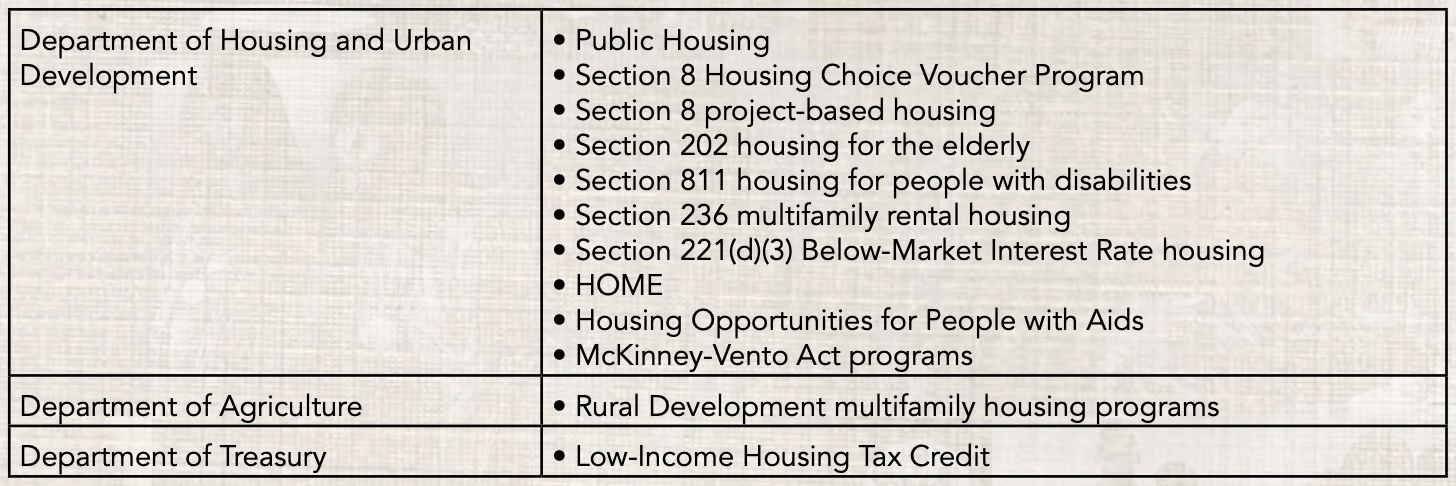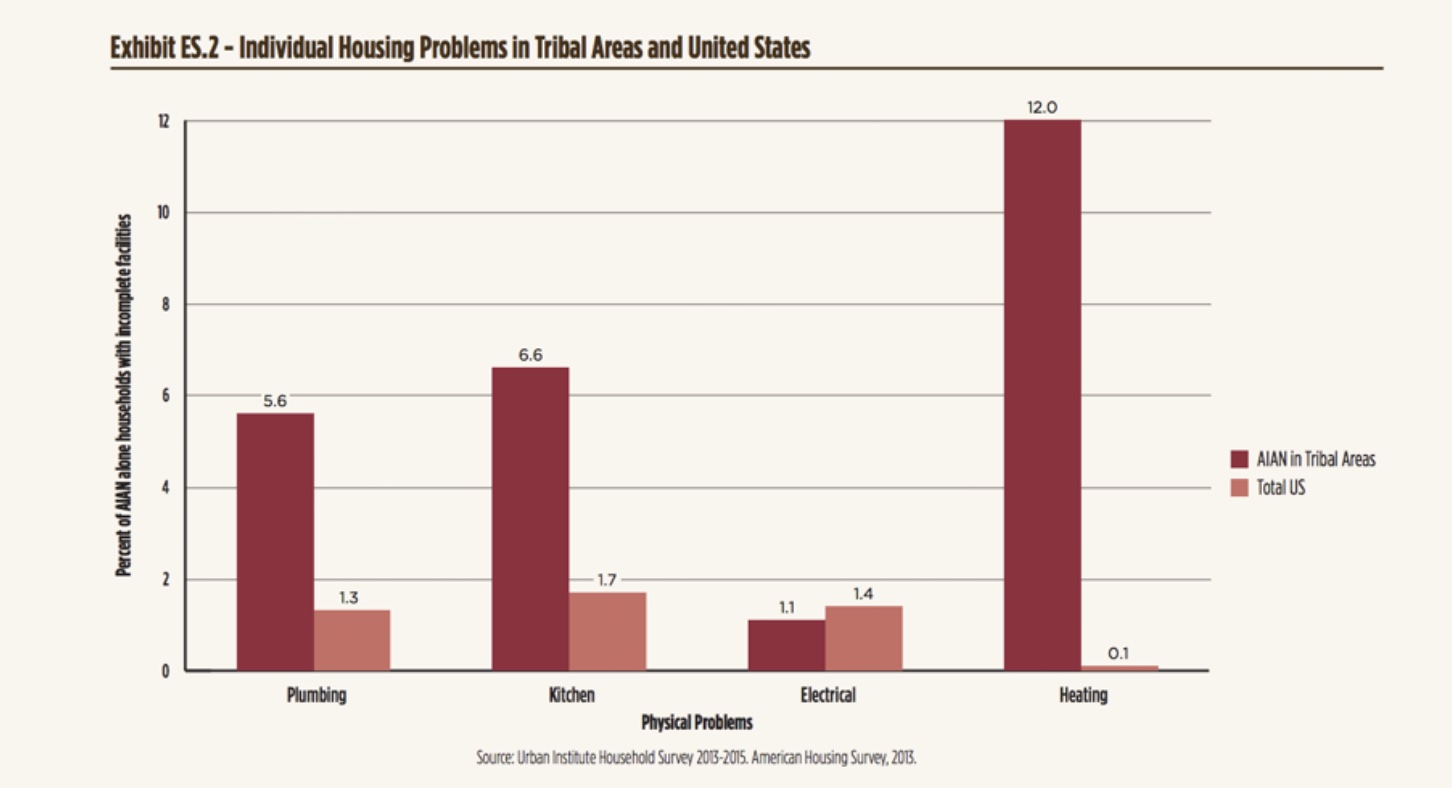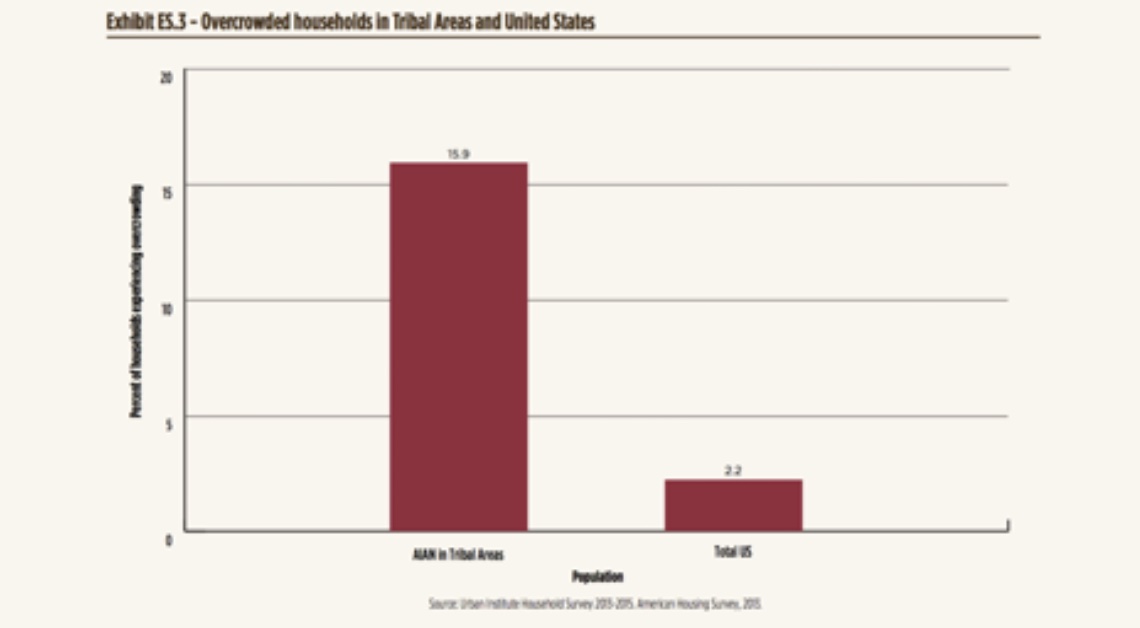Housing in Tribal Communities: Three Issues for Consideration of Safety for Native Women
The intersection of housing and gender-based violence is clear. The need for safe and affordable housing is one of the most pressing concerns for American Indian and Alaska Native (AI/AN) survivors of violence and abuse, as domestic and sexual violence is a leading cause of homelessness for women and children. Housing is a basic human right, yet AI/AN survivors of gender- based violence frequently report access or sustainability issues, leading to layers of vulnerability and increased risk of new or continued victimization. While there are continued issues for AI/AN survivors of abuse accessing or attempting to access shelters or emergency and transitional housing, this article does not focus on those outstanding issues. Rather, this article focuses on the availability of housing assistance in tribal communities, and on protections for survivors of abuse, primarily Native women, who utilize public housing assistance.
There are three issues to consider for AI/AN survivors: 1) the Violence Against Women Act of 2013 (VAWA) and the Native American Housing and Self Determination Act of 1966 (NAHASDA); 2) the role of tribal governments in tribally issued housing regulations that protect survivors; and 3) funding.
The Violence Against Women Act of 2013 (VAWA) and the Native American Housing and Self Determination Act of 1966 (NAHASDA)
VAWA 2013, in many ways, was a major step forward for survivors in marginalized communities. Immigrants, LGBTQ, and Indian tribes all advocated and witnessed hard-won historic improvements in strengthening protections for victims of VAWA-related crimes. Moreover, housing, as a separate intersection and issue area, also saw improvements in increased housing- related protections for survivors of abuse.
Most notably, VAWA 2013 expanded its VAWA 2005 housing protection provisions to provide protection to survivors of sexual assault. 1 The housing provisions now protect anyone who: 1) is a victim of actual or threatened domestic violence, dating violence, sexual assault, or stalking, or an “affiliated individual” of the victim and 2) who is living in, or seeking admission to, any of the covered housing programs (covered housing programs discussed later in this section).2
VAWA 2013 removed the VAWA 2005 requirement that the household member be related by blood or marriage to the victim. According to the National Housing Law Project, this means that VAWA 2013 now protects individuals who “simply live in the victim’s household, regardless of whether they are related by marriage or blood to the victim.”3 VAWA 2013 further revised the definition of “domestic violence” to include crimes of violence committed by an intimate partner of the victim or by a person who has cohabitated with the victim as an intimate partner. 4
VAWA 2013 prohibits any person from being denied assistance, tenancy, or occupancy rights to housing solely on the basis of criminal activity, if that activity is directly related to domestic violence, dating violence, sexual assault, or stalking engaged in by a household member, guest, or any person under the tenant’s control, if the tenant or affiliated individual of the tenant is the victim. 5
VAWA 2013, like VAWA 2005, allows covered housing programs to bifurcate a lease to evict or terminate assistance to any tenant or lawful occupant who engages in criminal acts of violence against an affiliated individual or others. VAWA 2013 also added a protection for tenants who remain in the housing as a result of the lease bifurcation. 6
VAWA 2013 revised the certification process under VAWA 2005. The new law permits public housing authorities, owners, and managers to request that a survivor certify via a form approved by the appropriate federal agency. The form has to state that an applicant or tenant is a victim of domestic violence, dating violence, sexual assault, or stalking; state that the incident that provides grounds for protection meets the requirements under the statute; and includes the name of the perpetrator (if the name is known and safe to provide).7 VAWA 2013 also expanded the forms of documentation to include one signed by a survivor and a mental health professional (under penalty of perjury). A survivor also has the option of providing an administrative record to document the abuse. Under the new law, instead of a certification form, the applicant or tenant may provide:
(a) Documentation signed by the survivor and a victim service provider, an attorney, a medical professional, or a mental health professional in which the professional attests under penalty of perjury to his or her belief that the victim has experienced abuse; or
(b) A federal, state, tribal, territorial, or local law enforcement, court, or administrative record.8
VAWA 2013 also included a new provision mandating that each federal agency adopt a model emergency transfer plan for covered entities to utilize.9 The plan must allow survivors to transfer to another available and safe dwelling unit assisted under a covered housing program if: the tenant expressly requests the transfer and the tenant “reasonably believes” that the tenant is threatened with imminent harm and further violence if the tenant remains within the same unit, or whether the tenant is a victim of sexual assault and that assault occurred within 90 days before the transfer request.10
Though there are other protections and improvements to be noted, the final issue for the purpose of this analysis relates to confidentiality. VAWA 2013 requires that a public housing authority, owner, or manager keep confidential the information that a survivor provides to certify victim status. This information cannot be entered into a shared database or disclosed to another entity unless the disclosure meets certain requirements (requested or consented to by the survivor in writing; required for use in an eviction proceeding to determine whether the incident qualifies as a serious or repeated violation of the lease, etc.).11
Prior to 2013, housing protections under VAWA 2005, only applied to public housing, the Section 8 Housing Choice Voucher Program, Section 8 project-based housing, Section 202 housing for the elderly, and Section 811 housing for people with disabilities. VAWA 2013 expanded the list of covered housing by including additional HUD programs and other affordable housing programs administered by the Department of Agriculture and the Department of Treasury. (http://nhlp.org/files/VAWA-2013-Bulletin-Article-Jan-2014-updated.pdf). VAWA 2013 now applies to the following covered housing programs in the table below.12
It is critical to note that the Indian Housing Block Grant (IHBG) under the NAHASDA has been expressly excluded from the expanded housing protections. This means that most tribal housing authorities do not have to comply with the housing provisions as expanded under VAWA 2013 and accordingly represents a serious gap in survivor protections. However, should the VAWA 2013 protections be expanded in 2018 to include Indian Housing Block Grants, and engagement with tribes in a government to government relationship be sidestepped, tribal sovereignty would be further degraded. Thus, we must understand that while VAWA 2013 housing protections are important for survivor safety, the NAHASDA is equally important for tribal sovereignty interests.
The NAHASDA reorganized the system of housing assistance provided to AI/ANs through HUD by eliminating several separate programs of assistance and replacing them with a block grant program.13 There are two programs authorized for Indian tribes under this Act: the Indian Housing Block Grant and Title VI Loan Guarantee, which provides financial guarantees to tribes for private market loans in order to develop affordable housing.14 In 2000, NAHASDA was amended to add Title VII, Housing Assistance for Native Hawaiians.15
NAHASDA’s Congressional findings state (in part):
“(2) there exists a unique relationship between the Government of the United States and the governments of Indian tribes and a unique Federal responsibility to Indian people; (3) the Constitution of the United States invests the Congress with plenary power over the field of Indian affairs, and through treaties, statutes, and historical relations with Indian tribes, the United States has undertaken a unique trust responsibility to protect and support Indian tribes and Indian people;
(4) the Congress, through treaties, statutes, and the general course of dealing with Indian tribes, has assumed a trust responsibility for the protection and preservation of Indian tribes and for working with tribes and their members to improve their housing conditions and socioeconomic status so that they are able to take greater responsibility for their own economic condition; (5) providing affordable homes in safe and healthy environments is an essential element in the special role of the United States in helping tribes and their members to improve their housing conditions and socioeconomic status...”16
These findings are critical because they highlight the continued commitment that Congress has made in recognizing its trust responsibility and in strengthening tribal sovereignty under its unique obligation to tribes. Furthermore, in recognizing the role of the trust relationship and with respect to tribal sovereignty, the NAHASDA includes a requirement for negotiated rulemaking. The Act states that in establishing the negotiated rulemaking committee, the Secretary shall— adapt the procedures for negotiated rulemaking in general to the unique government-to-government relationship between the Indian tribes and the United States, and shall ensure that membership of the committee include only representatives of the federal government and of geographically diverse, small, medium, and large Indian tribes. Thus, any changes to NAHASDA and the two programs it established, must go through this mandated process. This would include any applicability of other federal statutes, like VAWA 2013’s expanded housing protections.
In understanding what NAHASDA requires in the form of negotiated rulemaking and in knowing why that process is required, even as victim advocates, we can begin to understand and respect why the Indian Housing Block Grants were expressly excluded from the list of covered housing entities in VAWA 2013.

The Role of Tribal Governments in Tribally Issued Housing Regulations That Protect Survivors
As victim advocates and those that work in the field, we have to find ways to address victim needs while advocating for policy reform that respects tribal sovereignty. This can sometimes be challenging because sovereignty and the victim advocacy framework occasionally appear to be in conflict. However, knowing that through strengthening tribal sovereignty, we can best address the needs of victims in our communities, we can work through an adjusted framework: one that contemplates future survivors.
Regardless, it is clear that tribal victims in public housing run by tribal authorities funded by IHBGs will continue to experience a gap in protections that non-Native survivors utilizing public housing assistance do not. The question of how to address this issue remains.
One option, as contemplated above, is to amend (through the legislative process at the federal level) VAWA 2013 to include public housing assistance that is funded by IHBGs as covered entities. Again, this is not an acceptable reform. As stated above, this strategy would undermine tribal sovereignty and ignore long- standing statutory and regulatory policies recognizing the federal-tribal relationship while further sidestepping the negotiated rulemaking procedure that is mandated by NAHASDA.
A second and more viable option, which further supports tribal sovereignty is for tribal governments who receive IHBGs to include survivor protections within their respective tribal housing codes. This method would not only be respectful of tribal sovereignty, but would also be an exercise of tribal sovereignty. Most tribal housing codes do not include protections for victims of domestic violence, dating violence, sexual assault, and stalking. Some housing codes are outdated and actually harmful to victims of abuse. Examples (illustrative, not exhaustive) of harmful provisions in tribal housing codes include the following:
- Records of disturbance to neighbors by any household member as a basis for denial;
- Denial for any past convictions;
- Eligibility based on anyone in household over age 13 with a criminal history;
- One-strike eviction policies; and
- Evictions from private housing.
Tribal housing codes can be amended to remove harmful provisions and include provisions that prioritize survivor safety. Examples (illustrative, not exhaustive) of survivor-centered provisions that can be included in tribal housing codes include:
- Emergency transfer provisions;
- Lease bifurcation options;
- Self-certification provisions;
- Early lease termination;
- Confidentiality requirements around victim status; and
- Prohibitions on denials of assistance to victim based on criminal activity, when that activity is related to instances of abuse suffered by victim.
Adequate Funding Required
In January 2017, the Department of Housing and Urban Development (HUD) released a report titled, “Housing Needs of American Indians and Alaska Natives in Tribal Areas: A Report from the Assessment of American Indian, Alaska Native and Native Hawaiian Housing Needs” (https://www.huduser.gov/portal/sites/default/files/pdf/HousingNeedsAmerIndians-ExecSumm.pdf).
The need for meaningful access to public housing assistance is substantial in tribal communities. Compared with an average poverty rate of 18%, AI/AN- alone poverty rates stood at 22% in metropolitan areas outside of Indian Country, 28% in surrounding counties, and 32% in tribal areas. 17 The report begins by stating, “[d]uring the past two decades, although improvements have been made, the overcrowding and physical housing problems of American Indians and Alaska Natives (AI/ANs) living on reservations and other tribal areas remain strikingly more severe than those of other Americans.” 18 The report cites “particular circumstances” of tribal areas such as remoteness, lack of infrastructure, and complex legal and other constraints related to land ownership to explain the difficulties in improving housing conditions in tribal areas.19 The report further stated that “inadequate funding appears to be a major constraint at this point.”20
The HUD report includes findings and conclusions to determine the extent of housing problems and needs in Indian Country. HUD standards in general focus on physical problems in three categories:
- Systems deficiencies (plumbing, heating, etc.)
- Condition problems (structural issues, holes in the wall, etc.)
- Overcrowding (defined by having more than one person per room)21
The report concludes that “data from this project’s household survey show that physical housing problems for AI/AN households in tribal areas remain much more severe than for U.S. households, on average, in almost all categories.”22 The chart below illustrates the disparity.

The report found that 34% of AI/AN households had one or more physical problems, compared with only 7% for U.S. households. It estimated that in order to address these issues, it would have been necessary to build around 33,000 new units to eliminate overcrowding of the AI/AN population in tribal areas and another 35,000 new units to address or replace units that were barely habitable.23 The shortages illustrated with these statistics show that housing in Indian Country is yet another vulnerability that American Indians and Alaska Natives have inherited. But this vulnerability is one that survivors of domestic violence and their children simply cannot afford.
The study further confirmed, “what has become the conventional wisdom about homelessness in Indian Country, namely that, in tribal areas, homelessness mostly translates into overcrowding rather than having people sleeping on the street. The study estimates that, at the time of the household survey in 2013–2015, between 42,000 and 85,000 people in tribal areas were staying with friends or relatives only because they had no place of their own; that is, they were homeless.”24
The problem of overcrowding in tribal areas is illustrated in the chart below.

These issues illustrate the need for continued and increased NAHASDA funding. The President’s FY2019 budget unfortunately sought to cut NAHASDA by 54 million.25 In that same budget, The Native Hawaiian Housing Block Grant was not requested at all.26 Yet thankfully, the FY2019 Omnibus, funds the NAHASDA at $655,000,000 through September 30, 2022, and the Native Hawaiian Housing Block Grant at $2,000,000 through September 30, 2022 (level funding from FY2018). The FY2019 Omnibus essentially funds the programs at level funding. Full text of the FY2019 Omnibus can be found here https://docs.house.gov/billsthisweek/20180319/BILLS-115SAHR1625-RCP115-66.pdf. 27 While current levels of funding have been somewhat consistent, the effect/buying power of this funding in a positive trend has been “seriously eroded by inflation,” as well as population growth and increased construction costs.28 Given the clear physical and overcrowding problems in tribal housing as found in the HUD report, level funding will not address the severity of the housing crisis in tribal communities.
Looking to the Future
Public tribal housing assistance is a critical resource for AI/AN survivors of abuse. AI/AN survivors must have access to housing assistance that protects them regarding their unique vulnerabilities and increased risks. Though the VAWA 2013 expanded protections do not apply to IHBGs, tribal governments in an exercise of their sovereignty can include similar provisions in their tribal housing codes.
The 2018 annual consultation is schedule for August 21–22, 2018, and provides Indian tribes the opportunity to raise concerns regarding inadequate funding of tribal housing, NAHASDA, and the Native Hawaiian Housing Block Grant Program. It also provides tribal leaders the opportunity to raise their concerns and recommendations regarding the applicability of the VAWA housing protections to tribal housing within the authority of Indian tribes.
1. See generally 42 U.S.C.A. §14043e-11 (West 2014)
2. http://nhlp.org/files/VAWA-2013-Bulletin-Article-Jan-2014-updated.pdf
3. Id.
4. Id.
5. 42 U.S.C.A. §14043e-11(b)(3)(A) (West 2014).
6. 42 U.S.C.A. §14043e-11(b)(3)(i) (West 2014).
7. 42 U.S.C.A. §14043e-11(c)(3)(A) (West 2014).
8. 42 U.S.C.A. §14043e-11(c)(3)(B) (West 2014).
9. http://nhlp.org/files/VAWA-2013-Bulletin-Article-Jan-2014- updated.pdf
10. Id.
11. 42 U.S.C.A. § 14043e-11(c)(4) (West 2014).
12. 42 U.S.C.A. § 14043e-11(a)(3) (West 2014).
13. https://www.hud.gov/program_offices/public_indian_housing/ih/codetalk/nahasda
14. Id.
15. Id.
16. P.L. 104-330
17. Page 3, https://www.huduser.gov/portal/sites/default/files/pdf/HousingNeedsAmerIndians-ExecSumm.pdf
18. Id at 1.
19. Id.
20. Id.
21. Id at 4.
22. Id.
23. Id at 5.
24. Id at 6.
25. http://www.ncai.org/FY2019_Presidents_Budget_Analysis7.pdf
26. Id.
27. https://docs.house.gov/billsthisweek/20180319/BILLS-115SAHR1625-RCP115-66.pdf
28. Page 9, https://www.huduser.gov/portal/sites/default/files/pdf/HousingNeedsAmerIndians-ExecSumm.pdf





